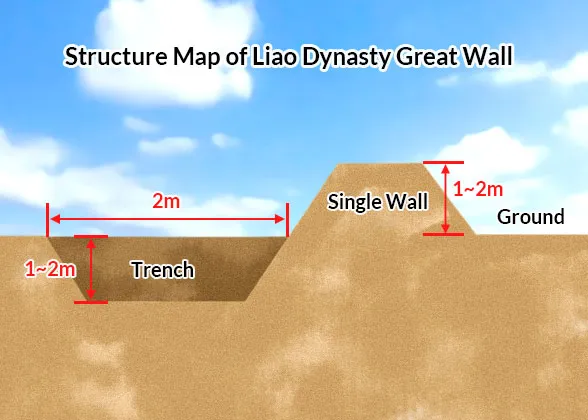Liao Dynasty Great Wall
The Great Wall of Liao Dynasty (907 – 1125) was largely built during the reign of Emperor Shengzong (972 – 1031) and Xingzong (1016 – 1055) for consolidation of the regime and the territorial expansion. It is also called Liao Bianhao with a trench dug in front of the single wall, extending 735 kilometers (457 miles) from today's Inner Mongolia in China to Mongolia via Russia.
When and Why Did the Liao Dynasty Build the Great Wall?
In the early days of the Liao Dynasty, Bohai Kingdom on the north of the state was a big concern to Emperor Taizu (872 – 926). So he ordered the construction of the Zhendonghaikou Great Wall in 908 along the southern border of Bohai Kingdom to block off Bohai's expansion. It is in nowadays Dalian of Liaoning Province.
After decades of peace, the boundary of Liao began to get attacked by nomadic tribes from time to time. Besides sending forces to suppress the rebellions, Emperor Shengzong and Xingzong commanded to build the Great Wall to draw out the boundary line with the nomads and also for better defenses. It extends for 735 kilometers (457 miles) along the Argun River from the southeast of Ergun City, Inner Mongolia, via Chita in Russia, and finally reaches the Mongolia, with 210 kilometers (130 miles) within the territory of China, 416 kilometers (259 miles) in Mongolia, and the rest 109 kilometers (68 miles) in Russia. Over 70 forts were built along the wall for stationing troops.
Liao Bianhao – A Unique Design of Liao Dynasty Great Wall
 |
| Structure of Liao Bianhao |
Unlike other common Great Wall sections with ramparts, stairs, and beacon towers, Liao Dynasty Great Wall is much simpler only consisting of a single wall and a trench in the front, and this special structure was named Bianhao in Chinese. The trench is usually 1~2 meters (3~7 feet) deep and around 2 meters (7 feet) wide and soils dug out from the trench were rammed beside one side of the trench to form the wall. Together they act as a barrier to block off soldiers and cavalries.
Zhendonghaikou Great Wall
Zhendonghaikou Great Wall was built in today's Dalian, Liaoning, stretching from Yandao Village all the way to Tuchengzi Village in the north, with a total length of less than 15 kilometers (9 miles). Most parts of the wall were built of rammed earth while the constructional material of a small proportion was the mixture of earth and stones. Although not as long as other Great Wall sections, Zhendonghaikou was built at the junction of the Liao and Bohai Kingdoms, because Emperor Taizu of Liao saw the latter as a major threat. This wall played an important role in the annexation of the Bohai Kingdom. After Liao finally occupied Bohai Kingdom in 926, Zhendonghaikou Great Wall was no longer a military facility but more like the 'customs', making Dalian a vital transit station for maritime trades between Liao and the central plain.
Relics of the Great Wall of Liao Dynasty
Due to lack of protection, Liao Dynasty Great Wall in Inner Mongolia has been severely damaged after hundreds of years of weathering and erosions. Most rammed ramparts have disappeared with faint traces among the wide prairie, but among all the military forts along the wall, 68 of them are still clearly visible nowadays.
The Zhendonghaikou Great Wall has not been immune to the erosions either with a large proportion of the ramparts damaged without traces. However, there are still some dilapidated walls to be found in Gangtou Village, Tuchengzi Village and Erdaoling Village.